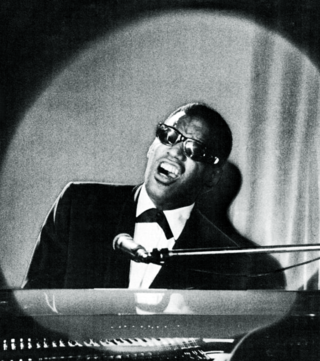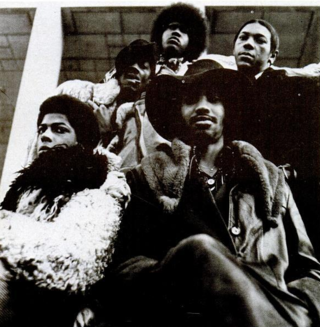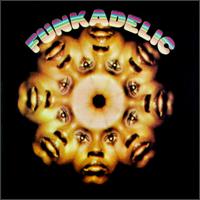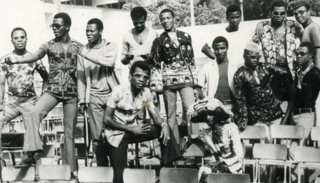
Funk is a music genre that originated in African-American communities in the mid-1960s when musicians created a rhythmic, danceable new form of music through a mixture of various music genres that were popular among African-Americans in the mid-20th century. It deemphasizes melody and chord progressions and focuses on a strong rhythmic groove of a bassline played by an electric bassist and a drum part played by a percussionist, often at slower tempos than other popular music. Funk typically consists of a complex percussive groove with rhythm instruments playing interlocking grooves that create a "hypnotic" and "danceable" feel. It uses the same richly colored extended chords found in bebop jazz, such as minor chords with added sevenths and elevenths, and dominant seventh chords with altered ninths and thirteenths.

Psychedelic rock is a rock music genre that is inspired, influenced, or representative of psychedelic culture, which is centered on perception-altering hallucinogenic drugs. The music incorporated new electronic sound effects and recording techniques, extended instrumental solos, and improvisation. Many psychedelic groups differ in style, and the label is often applied spuriously.

Soul music is a popular music genre that originated in the African American community throughout the United States in the late 1950s and early 1960s. It has its roots in African-American gospel music and rhythm and blues. Soul music became popular for dancing and listening, where U.S. record labels such as Motown, Atlantic and Stax were influential during the Civil Rights Movement. Soul also became popular around the world, directly influencing rock music and the music of Africa. It also had a resurgence in the mid-to late 1990s with the subgenre neo-soul, which added modern production elements and influence from hip-hop.

Parliament-Funkadelic is an American music collective of rotating musicians headed by George Clinton, primarily consisting of the funk bands Parliament and Funkadelic, both active since the 1960s. Their eclectic style has drawn on psychedelia, outlandish fashion, and surreal humor. They released albums such as Maggot Brain (1971), Mothership Connection (1975), and One Nation Under a Groove (1978) to critical praise, and scored charting hits with singles such as "Tear the Roof Off the Sucker" (1975) and "Flash Light" (1978). Overall, the collective achieved thirteen top ten hits in the American R&B music charts between 1967 and 1983, including six number one hits. Their work would have an influential effect on subsequent funk, post-punk, hip-hop, and techno artists of the 1980s and 1990s, while their collective mythology would help pioneer Afrofuturism.

Funkadelic was an American funk rock band formed in Plainfield, New Jersey in 1968 and active until 1982. As one of the two flagship groups of George Clinton's P-Funk collective, they helped pioneer the funk music culture of the 1970s. Funkadelic initially formed as a backing band for Clinton's vocal group the Parliaments, but eventually pursued a heavier, psychedelic rock-oriented sound in their own recordings. They released acclaimed albums such as Maggot Brain (1971) and One Nation Under a Groove (1978).

Edward Earl Hazel was an American guitarist and singer in early funk music who played lead guitar with Parliament-Funkadelic. Hazel was a posthumous inductee to the Rock and Roll Hall of Fame, inducted in 1997 with fifteen other members of Parliament-Funkadelic. His ten-minute guitar solo in the Funkadelic song "Maggot Brain" is hailed as "one of the greatest solos of all time on any instrument". In 2023, Rolling Stone ranked Hazel at no. 29 in its list of 250 of the greatest guitarists of all time.

Free Your Mind... and Your Ass Will Follow is the second studio album by American funk rock band Funkadelic, released in July 1970 by Westbound Records. It charted at No. 92 in the US, the band's highest charting album release until 1978's One Nation Under a Groove, and included the No. 82 single "I Wanna Know If It's Good to You?"

Maggot Brain is the third studio album by the American funk rock band Funkadelic, released by Westbound Records in July 1971. It was produced by bandleader George Clinton and recorded at United Sound Systems in Detroit during late 1970 and early 1971. The album was the final LP recorded by the original Funkadelic lineup; after its release, founding members Tawl Ross (guitar), Billy Nelson (bass), and Tiki Fulwood (drums) left the band for various reasons.

Funkadelic is the debut album by the American funk rock band Funkadelic, released in 1970 on Westbound Records.

Jazz fusion is a popular music genre that developed in the late 1960s when musicians combined jazz harmony and improvisation with rock music, funk, and rhythm and blues. Electric guitars, amplifiers, and keyboards that were popular in rock and roll started to be used by jazz musicians, particularly those who had grown up listening to rock and roll.
Psychedelic soul is a music genre that emerged in the late 1960s and saw Black soul musicians embrace elements of psychedelic rock, including its production techniques, instrumentation, effects units and drug influences. It came to prominence in the late 1960s and continued into the 1970s, playing a major role in the development of funk and disco.

Band of Gypsys is a live album by Jimi Hendrix and the first without his original group, the Jimi Hendrix Experience. It was recorded on January 1, 1970, at the Fillmore East in New York City with Billy Cox on bass and Buddy Miles on drums, frequently referred to as the Band of Gypsys. The album mixes funk and rhythm and blues elements with hard rock and jamming, an approach which later became the basis of funk rock. It contains previously unreleased songs and was the last full-length Hendrix album released before his death six months later.
Funk rock is a fusion genre that mixes elements of funk and rock. James Brown and others declared that Little Richard and his mid-1950s road band, the Upsetters, were the first to put the funk in the rock and roll beat, with a biographer stating that their music "spark[ed] the musical transition from fifties rock and roll to sixties funk".
Psychedelic music is a wide range of popular music styles and genres influenced by 1960s psychedelia, a subculture of people who used psychedelic drugs such as 5-MeO-DMT, DMT, LSD, mescaline, and psilocybin mushrooms, to experience synesthesia and altered states of consciousness. Psychedelic music may also aim to enhance the experience of using these drugs and has been found to have a significant influence on psychedelic therapy.

Orchestre Poly-Rythmo de Cotonou is a band from Cotonou, Benin, originally active from the 1960s to the 1980s and founded by singer-guitarist Mélomé Clément. They reformed in 2009 to international recognition. Their work has mixed styles such as funk, afrobeat, psychedelia, jazz and local voodoo influences. The Guardian called them "one of West Africa's best dance bands."
Psychedelic rap is a microgenre that fuses hip hop music with psychedelia. The genre's otherworldy sound was influenced by psychedelic rock and soul, funk and jazz, utilizing breaks and samples that create a hallucinogenic effect. Psychedelic drugs may also play a part in shaping the genre's sound.

There's a Riot Goin' On is the fifth studio album by American funk and soul band Sly and the Family Stone. It was recorded from 1970 to 1971 at Record Plant Studios in Sausalito, California and released later that year on November 1 by Epic Records. The recording was dominated by band frontman/songwriter Sly Stone during a period of escalated drug use and intra-group tension.
Avant-funk is a music style in which artists combine funk or disco rhythms with an avant-garde or art rock mentality. Its most prominent era occurred in the late 1970s and 1980s among post-punk and no wave acts who embraced black dance music.
Blo was a Nigerian psychedelic funk ensemble formed in Lagos and active between 1972 and 1982. The main trio consisted of Laolu "Akins" Akintobi (drums), Berkely "Ike" Jones (guitar), and Mike "Gbenga" Odumosu (bass). The group fused the Afrobeat rhythms of Nigeria with funk and psychedelia derived from '60s Western rock music.
Progressive soul is a type of African-American music that uses a progressive approach, particularly in the context of the soul and funk genres. It developed in the late 1960s and early 1970s through the recordings of innovative black musicians who pushed the structural and stylistic boundaries of those genres. Among their influences were musical forms that arose from rhythm and blues music's transformation into rock, such as Motown, progressive rock, psychedelic soul, and jazz fusion.













